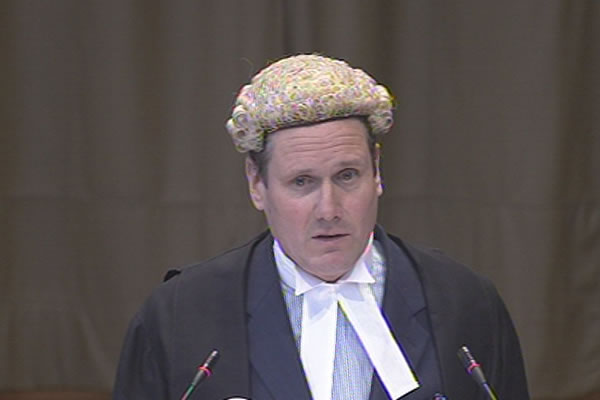Home
PATTERN OF ATTACK AND ‘CLEAR INTENT TO DESTROY’
At the public hearing in the case brought by Croatia against Serbia for violations of the Genocide Convention, the Croatian representatives continued presenting their arguments in the public hearing, highlighting the pattern of the attacks of the Serbian forces on the Croatian villages and towns with a ‘clear intent to destroy’ the civilian population
 Keir Starmer
Keir Starmer On the third day of the public hearings on the merits of the case brought by Croatia against Serbia for violations of the Convention for the Prevention and Punishment of the Crime of Genocide, British lawyer Blinne Ni Ghralaigh highlighted the pattern of the attacks of the Serbian forces on the Croatian villages and towns. The attacks were a ‘clear proof of the Serbian intent to destroy’ the Croatian population, said Ni Ghralaigh, who is representing Croatia.
Using the villages of Tovarnik, Bogdanovci, Lovas and Sotin in Eastern Slavonia to illustrate her point, Ni Ghralaigh described how the members of the local Territorial Defense, paramilitary formations and volunteers ‘under the JNA command and control’ participated in the widespread attacks on the Croatian population from July to December 1991. ‘Systematic, coordinated and pre-planned attacks’ followed the same pattern. First the JNA would surrounded a village, causing fear among the population. The next step was continuous shelling, followed by an ultimatum issued by the army to the villagers to lay down arms. After that, there would be another attack, and then the paramilitaries would arrive and proceed to ‘kill, loot, burn and abuse’ the local population. The attacks were not directed at legitimate military targets but at the civilian population with a ‘clear intent to destroy’ them, the Croatian representative said.
Ni Ghralaigh emphasized that the one year of occupation in Eastern Slavonia resulted in the deaths of about 4,000 men, women and children. Tens of thousands of people suffered grievous bodily harm, about 3,600 persons were detained in prison facilities in Croatia and Serbia, about 90,000 persons were forcibly expelled and about 300 churches were destroyed. The bodies of the victims were exhumed from about 510 mass graves, Ni Ghralaigh said.
London barrister Sir Keir Starmer spoke in detail about the crimes in and around Vukovar. In the first stage of the attack that began on 25 August 1991, tens of thousands of projectiles were fired on the town. There was no comparison between the Croatian and Serbian forces, Starmer said. By 18 November 1991, when the JNA captured Vukovar, ‘even birds had fled the town that was destroyed by shelling’. ‘The mushroom people’ who had spent three months in the basements without electricity, food and water, sought safety in the Vukovar Hospital. In the morning of 20 November 1991, the JNA soldiers entered the hospital, separated the men from the women and children and took them by bus to the Vukovar barracks. The buses ended up on the Ovcara farm, where the wounded and the sick were executed during the night at the execution site nearby, in Grabovo. Quoting from the Tribunal’s judgment in the case against the three JNA officers convicted of the crimes in Vukovar, Starmer noted that at least 194 persons were killed at Ovcara. Many are still missing. The British lawyer also addressed the killings and torture in the Velepromet warehouse. The crimes in the Vukovar area showed the existence of a ‘genocidal plan’ implemented by the Serbian forces, Starmer concluded. In Starmer’s view, the intent of the conquerors of Vukovar was not to evacuate but to ‘destroy’ its Croatian population.
After the British lawyer completed his presentation, Maja Sersic, a professor of international law from Zagreb, said that the villages of Skabrnja and Saborsko were ‘examples of genocidal behavior and the legacy of destruction’. The villagers, most of them elderly, were 'killed, hanged, buried alive’, noted Sersic adding that the ‘destruction is irrefutable evidence of genocide’.
The hearing continued with the evidence of Marija Katic and expert Ivan Grujic. The contents of their testimony will be available to the public after the public hearings end on 1 April 2014.
Linked Reports
- Case : Croatia vs. Serbia
- 2014-03-04 GENOCIDE WAS 'CUMULATIVE EFFECT OF A SERIES OF CRIMES'
- 2014-03-03 CROATIA: GENOCIDE IS NOT A NUMBERS GAME
- 2008-11-18 INTERNATIONAL COURT OF JUSTICE CONFIRMS IT HAS JURISDICTION IN CROATIA VS. SERBIA CASE
- 2014-03-06 CROATIA: SERBIA RESPONSIBLE FOR CRIMES COMMITTED BY JNA AND SERBIAN TROOPS
- 2014-03-07 IS THERE EVIDENCE OF SERBIA’S ‘GENOCIDAL INTENT’?
- 2014-03-10 SERBIA: GENOCIDE AGAINST SERBS, NOT CROATS
